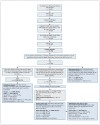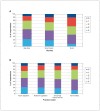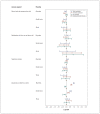Association of physician payment model and team-based care with timely access in primary care: a population-based cross-sectional study
- PMID: 32381684
- PMCID: PMC7207031
- DOI: 10.9778/cmajo.20190063
Association of physician payment model and team-based care with timely access in primary care: a population-based cross-sectional study
Abstract
Background: It is unclear how patient-reported access to primary care differs by physician payment model and participation in team-based care. We examined the association between timely and after-hours access to primary care and physician payment model and participation in team-based care, and sought to assess how access varied by patient characteristics.
Methods: We conducted a cross-sectional analysis of adult (age ≥ 16 yr) Ontarians who responded to the Ontario Health Care Experience Survey between January 2013 and September 2015, reported having a primary care provider and agreed to have their responses linked to health administrative data. Access measures included the proportion of respondents who reported same-day or next-day access when sick, satisfaction with time to appointment when sick, telephone access and knowledge of an after-hours clinic. We tested the association between practice model and measures of access using logistic regression after stratifying for rurality.
Results: A total of 33 665 respondents met our inclusion criteria. In big cities, respondents in team and nonteam capitation models were less likely to report same-day or next-day access when sick than respondents in enhanced fee-for-service models (team capitation 43%, adjusted odds ratio [OR] 0.88, 95% confidence interval [CI] 0.79-0.98; nonteam capitation 39%, adjusted OR 0.78, 95% CI 0.70-0.87; enhanced fee-for-service 46% [reference]). Respondents in team and nonteam capitation models were more likely than those in enhanced fee-for-service models to report that their provider had an after-hours clinic (team capitation 59%, adjusted OR 2.59, 95% CI 2.39-2.81; nonteam capitation 51%, adjusted OR 1.90, 95% CI 1.76-2.04; enhanced fee-for service 34% [reference]). Patterns were similar for respondents in small towns. There was minimal to no difference by model for satisfaction with time to appointment or telephone access.
Interpretation: In our setting, there was an association between some types of access to primary care and physician payment model and team-based care, but the direction was not consistent. Different measures of timely access are needed to understand health care system performance.
Copyright 2020, Joule Inc. or its licensors.
Conflict of interest statement
Competing interests: Tara Kiran was the Board Chair for the St. Michael’s Hospital Academic Family Health Team from 2014 to 2018. No other competing interests were declared.
Figures



Similar articles
-
Impact of Team-Based Care on Emergency Department Use.Ann Fam Med. 2022 Jan-Feb;20(1):24-31. doi: 10.1370/afm.2728. Ann Fam Med. 2022. PMID: 35074764 Free PMC article.
-
Capitation and enhanced fee-for-service models for primary care reform: a population-based evaluation.CMAJ. 2009 May 26;180(11):E72-81. doi: 10.1503/cmaj.081316. CMAJ. 2009. PMID: 19468106 Free PMC article.
-
Longitudinal evaluation of physician payment reform and team-based care for chronic disease management and prevention.CMAJ. 2015 Nov 17;187(17):E494-E502. doi: 10.1503/cmaj.150579. Epub 2015 Sep 21. CMAJ. 2015. PMID: 26391722 Free PMC article.
-
Impact of payment model on the behaviour of specialist physicians: A systematic review.Health Policy. 2020 Apr;124(4):345-358. doi: 10.1016/j.healthpol.2020.02.007. Epub 2020 Feb 22. Health Policy. 2020. PMID: 32115252
-
Contact time in GP Care: Descriptive patterns and a scoping review of the literature.Health Policy. 2025 Jun;156:105315. doi: 10.1016/j.healthpol.2025.105315. Epub 2025 Apr 10. Health Policy. 2025. PMID: 40273833
Cited by
-
Patients report high information coordination between rostered primary care physicians and specialists: A cross-sectional study.PLoS One. 2024 Aug 22;19(8):e0307611. doi: 10.1371/journal.pone.0307611. eCollection 2024. PLoS One. 2024. PMID: 39172961 Free PMC article.
-
Comparing primary care Interprofessional and non-interprofessional teams on access to care and health services utilization in Ontario, Canada: a retrospective cohort study.BMC Health Serv Res. 2021 Sep 14;21(1):963. doi: 10.1186/s12913-021-06595-x. BMC Health Serv Res. 2021. PMID: 34521410 Free PMC article.
-
Will blended family physician payment models revive primary care in Canada?Can Fam Physician. 2025 Jun;71(6):377-379. doi: 10.46747/cfp.7106377. Can Fam Physician. 2025. PMID: 40523742 Free PMC article. No abstract available.
-
Virtual Visits With Own Family Physician vs Outside Family Physician and Emergency Department Use.JAMA Netw Open. 2023 Dec 1;6(12):e2349452. doi: 10.1001/jamanetworkopen.2023.49452. JAMA Netw Open. 2023. PMID: 38150254 Free PMC article.
-
Primary care bonus payments and patient-reported access in urban Ontario: a cross-sectional study.CMAJ Open. 2021 Nov 30;9(4):E1080-E1096. doi: 10.9778/cmajo.20200235. Print 2021 Oct-Dec. CMAJ Open. 2021. PMID: 34848549 Free PMC article.
References
-
- Starfield B. Primary care: balancing health needs, services, and technology. Oxford (UK): Oxford University Press; 1998.
-
- How Canada compares: results from the Commonwealth Fund’s 2016 international health policy survey of adults in 11 countries. Ottawa: Canadian Institute for Health Information; 2017.
-
- Iglehart JK. No place like home — testing a new model of care delivery. N Engl J Med. 2008;359:1200–2. - PubMed
Publication types
MeSH terms
Grants and funding
LinkOut - more resources
Full Text Sources
Miscellaneous
